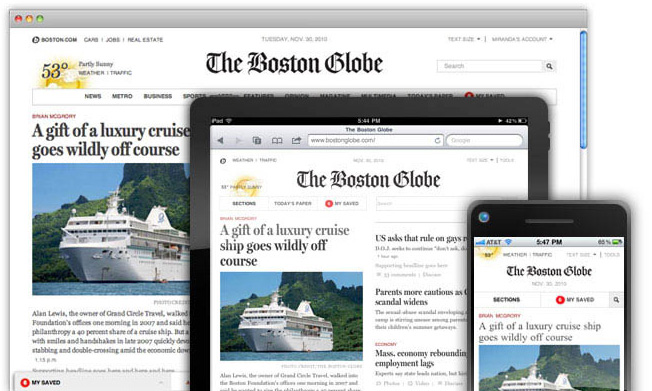Save 50% on a 3-month Digiday+ membership. Ends Dec 5.

The platform world can be a headache for publishers. There are now a seemingly endless variety of ways to reach online audiences, each requiring different versions of the content.
But as devices and platforms become increasingly fragmented, some publishers are turning their backs on distribution mechanisms like native apps and smartphone-specific experiences in favor of responsive Web design, which simply rearranges website content and displays it in a manor suitable for whichever screen it’s being viewed on.
The Boston Globe, for example, rolled out a completely responsive site last September. The site morphs on-the-fly for smartphones, tablets, and desktops. Other major online publishers such as the BBC say responsive products are in the works. These versions would theoretically do away with the need for separate apps.
“We had the opportunity to build from scratch, and decided this would be the best route to take,” said Jeff Moriarty, vp of digital products at The Boston Globe. “We saw the chance to really prepare ourselves for a mobile future. We could have just built a smartphone version, but that wouldn’t have helped us with the rise of tablets. There are so many different screen sizes proliferating now that we wanted to make sure we didn’t miss out on those opportunities.”
The publisher essentially opted to build six different versions of the site, the most suitable of which is displayed based on the screen size of the device it’s being viewed on. That basically meant six times as much work, Moriarty said, but it’s already starting to pay off as new devices hit the market.
“One thing that really validated our approach was the advent of the Kindle Fire, which launched after our site. We’d already built for that screen size and it worked great on day one. Yes it’s more work up-front, but ultimately you’re providing a better user experience,” he said.
Khoi Vinh, former design director at NYTimes.com, agreed that responsive sites are definitely something publishers should be considering. “I do believe that responsive design is the way to tackle any new web-based information presentation now,” he said, though he recognized that they can be difficult to implement due to the complexity of the production process associated with them.
Ad position: web_incontent_pos1
But one major challenge lies on the business front. For publishers that rely heavily on advertising and sponsorships for their revenues, it can be difficult to work those opportunities into a responsive site successfully.
The Boston Globe is fortunate, given that the majority of its revenues are gleaned from subscription fees, rather than ads. It didn’t have to worry as much about things like ad unit sizes and rich media, and could focus on the display of its content.
Startups such as ResponsiveAds are working on a solution to the problem that would allow regular display ads to become as responsive as the Web design template. “This is just the tip of the iceberg,” said Matthew Snyder, the firm’s CEO. “All of the major publishers I’ve spoken to have one or more responsive sites in the works.”
The Globe has experimented with responsive advertising, and ran a campaign for JetBlue using it late last year. The ad, built in HTML in conjunction with the airline’s agency Mullen, stretched to fit the size of the screen it was being viewed on.
But ultimately, most agencies aren’t yet set up to take advantage of responsive design, and nor necessarily should they be. Few publishers currently make of the technology, for example, and there’s no guaranteed it’ll be adopted ubiquitously. That said, its prominence is certainly growing. Moriarty said he’s had “an incredible amount” of publishers calling him since the Boston Globe site launched, with questions about how they can achieve similar results.
Ad position: web_incontent_pos2
“I can see that there could be opportunities for publishers around this, but agencies and advertisers aren’t buying that way yet. They’re still buying mobile separately to desktop, as they are with iPad in many cases,” Moriarty said. “You can’t get too far out ahead of the market.”
The responsive movement also raises questions about the future of native applications. Though native apps can clearly have benefits, for purposes such as distribution and more successful ad targeting, responsive design has the potential to make the Web a much more mobile and tablet-friendly place to be.
“We could have spent energy building things like iPad apps, but we ultimately decided to try and make it work as great as possible on the Web,” said Morarity. “It’s a constant question we ask ourselves, though. There’s a chance we may develop native apps, too.”
Other subscription-based publishers have already voted with their feet, opting to go the Web-route over paying intermediaries such as Apple for distribution. The Financial Times, for example, has pulled its iOS apps from the AppStore, and instead drives users to its HTML5-based in-browser Web-app.
Ultimately, Moriarty suggested the Globe may pursue a similar path, concluding. “Our belief is we can reach a lot of the people we want with a website.”
More in Media

What publishers are wishing for this holiday season: End AI scraping and determine AI-powered audience value
Publishers want a fair, structured, regulated AI environment and they also want to define what the next decade of audience metrics looks like.

Digiday+ Research Subscription Index 2025: Subscription strategies from Bloomberg, The New York Times, Vox and others
Digiday’s third annual Subscription Index examines and measures publishers’ subscription strategies to identify common approaches and key tactics among Bloomberg, The New York Times, Vox and others.

From lawsuits to lobbying: How publishers are fighting AI
We may be closing out 2025, but publishers aren’t retreating from the battle of AI search — some are escalating it, and they expect the fight to stretch deep into 2026.
Ad position: web_bfu